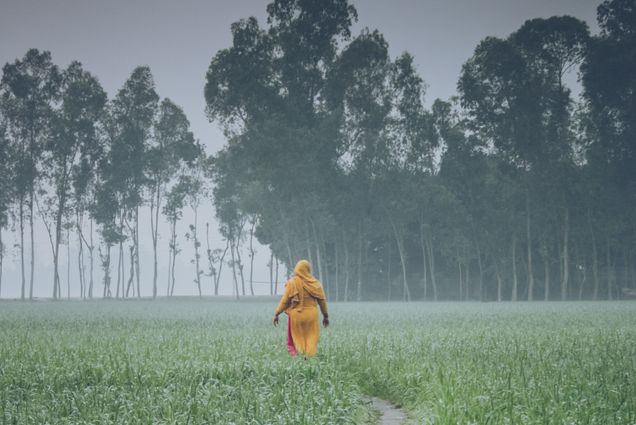Summer in the Field: Women’s Empowerment and Health-seeking Behavior in Bangladesh


Despite being large in numbers, women remain socially marginalized and underrepresented in low-income countries.
They are more likely to drop out of school and less likely to get formal employment. Even those who participate, receive less wages and suffer more in employment loss. They often lack autonomy in healthcare decisions where social custom maintains patriarchal norms. For instance, women alone have only 12 percent decision-making autonomy concerning their healthcare in Bangladesh. This lack of capability influences women’s power, choice and control regarding health-seeking behaviors.
Conversely, women’s empowerment through agency and high socio-economic status is often observed as a key indicator for positive public health outcomes. For instance, a study using data from 219 countries shows that for one additional year of schooling by girls of reproductive age, child mortality decreased by 9.5 percent.
In Bangladesh, women’s empowerment is conceived to be a key driver in the country’s transition into the middle Human Development category. Despite low per capita income compared to its neighbors, the country has seen a remarkable improvement in child immunization and fertility decline. For instance, the child mortality rate reduced from 146 in 1990, to 29 in 2020. Similarly, the female literacy rate improved from 26 percent to 72 percent during the same time.
Despite this, women continue to remain socially marginalized and underrepresented in Bangladesh. It is one of the worst-performing countries in terms of child marriage (51.4 percent of women are married before age 18) and intimate partner violence (54.2 percent of married women experienced violence in the last 12 months). Despite being a primary wage earner, the social value of women remains substandard in Bangladesh. Within households, they continue to remain marginalized and excluded from key decision-making processes.
According to Naila Kabeer, “women’s empowerment is about the process by which those who have been denied the ability to make strategic life choices acquire such an ability.” Researchers and policymakers differ in their conceptualization and formulation of women’s empowerment. Economic indicators are one of the most frequently used measures for women’s empowerment. It is the strongest predictor of women’s overall status. For instance, in Bangladesh, a study observed women’s working status as the best predictor for their health-seeking behavior. Similarly, according to Human Development Report 2021-2022, education is a key to empowerment that prevents discrimination and shape agency. In rural Bangladesh, education has a positive effect on the probability of having healthy children and household expenditure on nutrition and sanitation.
As part of the 2023 Summer in the Field Fellowship Program at the Boston University Global Development Policy Center, I conducted fieldwork to better understand the mechanism through which women navigate their empowerment status in the face of structural inequalities in day-to-day life that shape their health-seeking behavior. Moreover, I investigated whether women could use their resources (education and employment) to transform the ‘existence of choice’ into an ‘exercise of choice’ for better health outcomes. For this, I conducted in-depth qualitative interviews of married women of reproductive age (18-49) who qualify for educational and employment criteria. I asked them open-ended questions about their background and family members, as well as questions about their participation in the decision-making process in the family, both general (e.g., related to the marriage), as well as healthcare-related decisions.
A preliminary analysis of my interview data shows that even though educated and working women participated in household decision-making, including healthcare, it was their husbands and male guardians who held the key decision-making authority in the family. Nevertheless, I also noticed that working women relatively have greater flexibility in terms of making healthcare decisions. For instance, one of the key questions was if women need to get permission from their husbands/male guardians to seek healthcare. It was observed that women who work outside often do not wait for their husbands to decide about their personal and children’s health. They are also more likely to alter their husbands’ decisions than those who do not work, whereas most of the women who identified themselves as housewives reported trusting their husbands on key healthcare decisions.
Regarding their experience during pregnancy, it was their husbands and male guardians who mostly made decisions about women’s antenatal care visits and the type of delivery. It was a common trend across the sample, regardless of employment status. In some cases, female guardians were also involved in making decisions. In one case, however, one of the working respondents reported that she made all the decisions during pregnancy, due to her family’s unstable income and the couple’s unplanned pregnancy, she was indirectly forced to bear all the expenses and decisions.
Some of the questions in the interview focused on understanding the relative status of the women in the household. I asked respondents if the other family members consulted them for their healthcare decisions. Most of them said they were often consulted by other family members because of their higher educational attainments or work status. In some cases where educational empowerment did not translate into greater decision-making autonomy, it was still significant for many women in the household to maintain a respectful status as others trusted judgments regarding healthcare decisions. Overall, women with educational and economic empowerment may not alter or challenge dominant patriarchal family relations, but they can bargain to maintain a key status within households in Bangladesh.
Though the survey findings are preliminary, I hope this study will contribute to policy initiatives that move not only ensure access to education or work but also address the structural inequality that shapes women’s agency and access to resources. This will improve the quality of women’s lives by giving them more opportunities to ensure a healthy life for themselves and their children.
*
Learn more about the Summer in the Field Fellowship Program.

